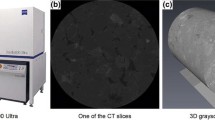Abstract
In this study, we numerically cemented a segmented X-ray microtomography image of a sandstone to understand changes to pore space connectivity, capillary control on gas, and water distributions, and ultimately production behavior in tight gas sandstone reservoirs. Level set method-based progressive quasi-static algorithm (a state-of-the-art direct simulation of capillarity-dominated fluid displacement) was used to find the gas/water configurations during drainage and imbibition cycles. Further, we account for gas–water interfacial tension changes using 1D burial history model based on available geologic data. We have found the displacement simulation method robust, and that diagenetic changes impart a significantly larger effect on gas trapping compared with interfacial tension changes.
Similar content being viewed by others
References
Bakke, S., Øren, P.-E.: 3-D pore-scale modelling of sandstones and flow simulations in the pore networks. SPE J. 2(2), 136–149 (1997)
Benedict M.: An empirical equation for thermodynamic properties of light hydrocarbons and their mixtures II mixtures of methane, ethane, propane, and n-butane. J. Chem. Phys. 10, 747 (1942)
Benedict M., Webb G.B., Rubin L.C.: An empirical equation for thermodynamic properties of light hydrocarbons and their mixtures I methane, ethane, propane and n-butane. J. Chem. Phys. 8, 334 (1940)
Byrnes, A.P., Cluff, R.M.: Analysis of Critical Permeablity, Capillary Pressure and Electrical Properties for Mesaverde Tight Gas Sandstones from Western U.S. Basins, U.S. Department of Energy. Available at: http://www.kgs.ku.edu/mesaverde/reports.html (2009)
Firoozabadi, A.F., Ramey, H.J., Jr.: Surface tension of water-hydrocarbon systems at reservoir conditions. J. Can. Petrol. Technol. 27, 41–48 (1988)
Flannery B.P. et al.: Three-dimensional X-ray microtomography. Science 237(4821), 1439–1444 (1987)
Iassonov, P., Gebrenegus, T., Tuller, M.: Segmentation of X-ray computed tomography images of porous materials: a crucial step for characterization and quantitative analysis of pore structures. Water Resour. Res. 45(9), W09415, 12pp (2009)
Lee T.-C., Kashyap R.L., Chu C.-N.: Building skeleton models via 3-D medial surface axis thinning algorithms. CVGIP: Graph. Models Image Process. 56, 462–478 (1994)
Lindquist, W.B.: 3DMA-Rock, a software package for automated analysis of rock pore structure in 3D computed microtomography images. http://www.ams.sunysb.edu/~lindquis/3dma/3dma_rock/3dma_rock.html. Accessed 31 January 2010
Lindquist W.B., Venkatarangan A.B.: Investigating 3D geometry of porous media from high resolution images. Phys. Chem. Earth A 25, 593–599 (1999)
Meakin, P., Tartakovsky, A.M.: Modeling and simulation of pore-scale multiphase fluid flow and reactive transport in fractured and porous media. Rev. Geophys. 47(3), RG3002, 47pp (2009)
Mehmani, A., et al.: The effect of microporosity on transport properties in tight reservoirs. In: SPE Americas Unconventional Gas Conference and Exhibition. Society of Petroleum Engineers (2011)
Miller M., Shanley K.: Petrophysics in tight gas reservoirs—key challenges still remain. Lead. Edge 29(12), 1464–1469 (2010)
Motealleh, S., Bryant, S.: Quantitative mechanism for permeability reduction by small water saturation in tight-gas sandstones. SPE J. 14(2) (2009)
Mousavi, M., Bryant, S.: Geometric models of porosity reduction mechanisms in tight gas sands. In: Proceedings of Rocky Mountain Oil & Gas Technology Symposium (2007)
Øren P.-E., Bakke S.: Reconstruction of Berea sandstone and pore-scale modelling of wettability effects. J. Petrol. Sci. Eng. 39(3–4), 177–199 (2003)
Øren P.-E., Bakke S., Held R.: Direct pore-scale computation of material and transport properties for North Sea reservoir rocks. Water Resour. Res. 43, 11 (2007)
Osher, S., Sethian, J.A.: Fronts propagating with curvature–dependent speed: Algorithms based on Hamilton-Jacobi formulations. J. Comput. Phys. 79(1), 12–49 (1988)
Osher S.J., Fedkiw R.P.: Level Set Methods and Dynamic Implicit Surfaces, 1st edn. Springer, Berlin (2002)
Prodanović, M.: Level Set Method based Progressive Quasi-Static (LSMPQS) software.http://users.ices.utexas.edu/~masha/lsmpqs/index.html. Accessed 30 January 2010
Prodanović M., Bryant S.: A level set method for determining critical curvatures for drainage and imbibition. J. Colloid Interface Sci. 304(2), 442–458 (2006)
Prodanović M., Lindquist W.B., Seright R.S.: Porous structure and fluid partitioning in polyethylene cores from 3D X-ray microtomographic imaging. J. Colloid Interface Sci. 298(1), 282–297 (2006)
Prodanović M., Lindquist W.B., Seright R.S.: 3D image-based characterization of fluid displacement in a Berea core. Adv. Water Resour. 30(2), 214–226 (2007)
Prodanović, M., Bryant, S., Karpyn, Z.: Investigating matrix-fracture transfer via a level set method for drainage and imbibition. In: SPE Annual Technical Conference and Exhibition (2008)
Prodanović, M., Bryant, S., Karpyn, Z.: Investigating matrix/fracture transfer via a level set method for drainage and imbibition. SPE J. 15(1) (2010)
Sethian, J.A.: Level Set Methods and Fast Marching Methods: Evolving Interfaces in Computational Geometry, Fluid Mechanics, Computer Vision, and Materials Science, 2nd edn. Cambridge University Press (1999)
Sheppard, A.P., et al.: Analysis of rock microstructure using high resolution X-ray tomography. In: Proceedings of the International Symposium of the Society of Core Analysts. International Symposium of the Society of Core Analysts. Trondheim, Norway, SCA, pp. 2006–2026 (2006)
Shin H. et al.: Analysis of the vesicular structure of basalts. Comput. Geosci. 31, 473–487 (2005)
Starling K.E.: Fluid Thermodynamic Properties for Light Petroleum Systems. Gulf Publishing Co., Houston (1973)
Torskaya, T., Jin, G., Torres-Verdin, C.: Pore-level analysis of the relationship between porosity, irreducible water saturation, and permeability of clastic rocks. In: Proceedings of SPE Annual Technical Conference and Exhibition (2007)
Turner M.L. et al.: Three-dimensional imaging of multiphase flow in porous media. Phys. A: Stat. Mech. Appl. 339(1–2), 166–172 (2004)
Wildenschild D. et al.: Using X-ray computed tomography in hydrology:systems, resolutions, and limitations. J. Hydrol. 267(3–4), 285–297 (2002)
Yurewicz, D.A., et al.: Controls on gas and water distribution, mesaverde basin-centered gas play, Piceance Basin, Colorado. In: Cumella, S.P., Shanley, K.W., Camp, W.K. (eds.) Understanding, Exploring, and Developing Tight-Gas Sands—2005 Vail Hedberg Conference, pp. 105–136. The American Association of Petroleum Geologists, Tulsa, Oklahoma, USA (2005)
Author information
Authors and Affiliations
Corresponding author
Rights and permissions
About this article
Cite this article
Prodanović, M., Bryant, S.L. & Davis, J.S. Numerical Simulation of Diagenetic Alteration and Its Effect on Residual Gas in Tight Gas Sandstones. Transp Porous Med 96, 39–62 (2013). https://doi.org/10.1007/s11242-012-0072-3
Received:
Accepted:
Published:
Issue Date:
DOI: https://doi.org/10.1007/s11242-012-0072-3




